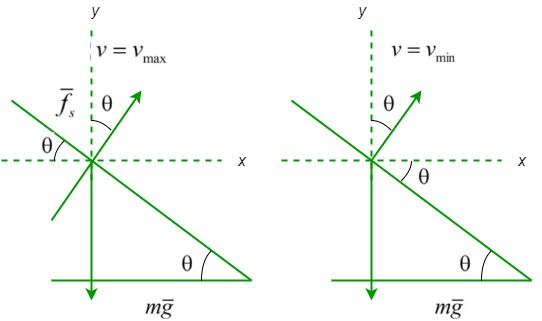
Concept explainers
To Find: The safe range of speeds
Answer to Problem 97P
Explanation of Solution
Given Information:
Radius of the curve is
Mass of the car,
Speed of the car is
The coefficient of static friction between the road and the tires is
Formula Used:
Newton’s second law of motion:
Where, m is mass and a is acceleration.
Calculation:

From the Free body diagram is shown above. When the coefficient of static friction is zero along x-axis,
And along y-axis
Along x-axis
And along y-axis
Now the force of static friction is given as
Substituting
Now dividing
Now when the car is traveling at maximum speed:
Along x-axis
And along y-axis
Now the force of static friction is given as
Substituting
Now dividing
Conclusion:
The safe range of speed is
Want to see more full solutions like this?
Chapter 5 Solutions
Physics for Scientists and Engineers
- Problem 5: A car negotiates an unbanked 85.2 m radius curve at 19.9 m/s. Calculate the minimum coeficient of friction needed to negotiate the curve. Hg = || sin() cotan() atan() cosh() cos() asin() acotan() tanh() O Degrees tan() ♫ acos() E sinh() cotanh() Radians 7 ^^^ 4 1 1 + 0 VO BACKSPACE * ∞02 - 8 9 5 63 DEL HOME END CLEARarrow_forwardA 1500-kg car approaches a horizontal curve at constant speed of 30 m/s. The radius of the curve is 180 m. What must be the minimum value for the coefficient of static friction between the tires and the road in order for hte car to round the curve without skidding?arrow_forwardThe curved section of a horizontal highway is a circular unbanked arc of radius 520 m. If the coefficient of static friction between this roadway and typical tires is 0.30, what would be the maximum safe driving speed for this horizontal curved section of highway?arrow_forward
- A race car travels 76 m/s around a circulartrack of radius 159 m What is the magnitude of the resultantforce on the 1600 kg driver and his car ifthe car does not slip?Answer in units of kN.arrow_forwardAs you are riding in a 1650-kg car, you approach a N7M.8 hairpin curve in the road whose radius is 50 m. The road- bed is banked inward at an angle of 10° (a) Suppose the road is very icy, so that the coefficient of static friction is essentially zero. What is the maximum speed at which you can go around the curve? (b) Now suppose the road is dry and that the static friction coefficient between the tires and the asphalt road is 0.6. What is the maximum speed at which you can safely go around the curve?arrow_forwardA curve on a flat road has curvature radius 123 mm, and a caution sign urges drivers to slow to 60 km/hkm/h before negotiating the curve. Find the minimum frictional coefficient safe for driving at this speed along the curve of the road.arrow_forward
- A car rounds a level turn with an 85-m radius. Suppose it is an icy day when the coefficients of static and kinetic friction between the car's tires and road are .15 and .13, respectively. What is the largest speed the car can take the turn withoit slipping?arrow_forwardThe drawing shows a baggage carousel at an airport. Your suitcase has not slid all the way down the slope and is going around at a constant speed on a circle ((r = 8.90 m) as the carousel turns. The coefficient of static friction between the suitcase and the carousel is 0.640, and the angle 0 in the drawing is 5.90°. How much time is required for your suitcase to go around once? Assumme that the static friction between the suitcase and the carousel is at its maximum.arrow_forwardIs it safe to drive your 1600-kg car at speed 27 m/s around a level highway curve of radius 150 m if the effective coefficient of static friction between the car and the road is 0.40?arrow_forward
- An automobile moves on a level horizontal road in a circle of radius 50 m. The coefficient of static friction between tires and road is 0.50. (a) Calculate the maximum speed with which this car can round this curve. Now, suppose the road is covered with ice, there is no friction. Instead, the road is banked. (b) Calculate the angle the road must be banked at in order to make the car round the curve with the same maximum speed.arrow_forwardAt what maximum speed can a car negotiate a turn on a wet road with coefficient of static friction 0.200 without sliding out of control? The radius of the turn is 27.5 m.arrow_forwardIf a car takes a banked curve at less than a given speed, friction is needed to keep it from sliding toward the inside of the curve (a real problem on icy mountain roads). a) Calculate the minimum speed, in meters per second, required to take a 84 m radius curve banked at 14° so that you don't slide inwards, assuming there is no friction. b)What is the minimum coefficient of friction needed for a frightened driver to take the same curve at 25 km/h?arrow_forward
 Physics for Scientists and Engineers: Foundations...PhysicsISBN:9781133939146Author:Katz, Debora M.Publisher:Cengage Learning
Physics for Scientists and Engineers: Foundations...PhysicsISBN:9781133939146Author:Katz, Debora M.Publisher:Cengage Learning
